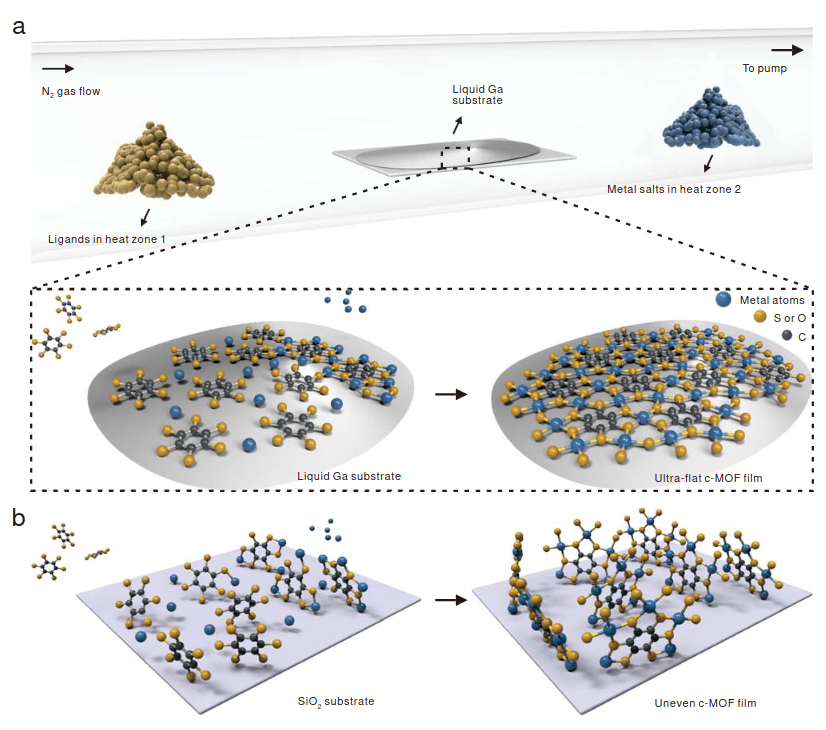Conductive metal–organic frameworks (MOFs) are emerging electroactive materials for (opto)electronics; however, it is challenging to achieve MOF-based devices using existing synthesis methods. Here we develop an on-liquid-gallium surface synthesis (OLGSS) strategy under chemical vapour deposition conditions for the controlled growth of two-dimensional conjugated MOF (2D c-MOF) thin films, which gives a tenfold improvement in surface flatness compared with traditionally synthesized c-MOFs. The basis for constructing these flatter surfaces is a layer-by-layer chemical vapour deposition growth mode, which is triggered by the high adhesion energy between gallium and aromatic ligands. We demonstrate the generality of the OLGSS strategy by reproducing flat surfaces for nine different 2D c-MOF films with variable thicknesses (∼2–208 nm). Compared to traditionally synthesized MOF films, the resultant ultrasmooth films enable the formation of high-quality electrical contacts with contact resistance reduced by over 13-fold. Furthermore, due to the efficient interfacial interaction, the prepared van der Waals heterostructure of OLGSS c-MOF and MoS2 shows intriguing photoluminescence enhancement, photoluminescence peak shift and work function modulation. This robust OLGSS method provides the opportunity to develop MOF electronics and shows promise for the construction of multicomponent MOF-based heterostructure materials.

Conductive metal–organic frameworks (MOFs) are emerging electroactive materials for (opto)electronics; however, it is challenging to achieve MOF-based devices using existing synthesis methods. Here we develop an on-liquid-gallium surface synthesis (OLGSS) strategy under chemical vapour deposition conditions for the controlled growth of two-dimensional conjugated MOF (2D c-MOF) thin films, which gives a tenfold improvement in surface flatness compared with traditionally synthesized c-MOFs. The basis for constructing these flatter surfaces is a layer-by-layer chemical vapour deposition growth mode, which is triggered by the high adhesion energy between gallium and aromatic ligands. We demonstrate the generality of the OLGSS strategy by reproducing flat surfaces for nine different 2D c-MOF films with variable thicknesses (∼2–208 nm). Compared to traditionally synthesized MOF films, the resultant ultrasmooth films enable the formation of high-quality electrical contacts with contact resistance reduced by over 13-fold. Furthermore, due to the efficient interfacial interaction, the prepared van der Waals heterostructure of OLGSS c-MOF and MoS2 shows intriguing photoluminescence enhancement, photoluminescence peak shift and work function modulation. This robust OLGSS method provides the opportunity to develop MOF electronics and shows promise for the construction of multicomponent MOF-based heterostructure materials.
